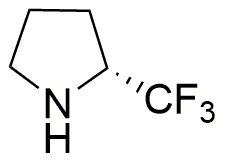(R)-(-)-2-(Trifluoromethyl)pyrrolidine is widely utilized in research focused on:
- Pharmaceutical Development: This compound serves as an important intermediate in the synthesis of various pharmaceuticals, particularly in the development of drugs targeting neurological disorders.
- Agricultural Chemistry: It is used in the formulation of agrochemicals, enhancing the efficacy of pesticides and herbicides by improving their stability and bioactivity.
- Material Science: The compound is incorporated into polymer formulations to impart unique properties, such as increased thermal stability and chemical resistance, making it valuable in producing advanced materials.
- Fluorine Chemistry: As a fluorinated compound, it plays a crucial role in the study of fluorine's effects on chemical reactivity, which is essential for developing new fluorinated compounds with specific properties.
- Research in Organic Synthesis: It is often used as a building block in organic synthesis, allowing chemists to create complex molecules more efficiently, which is beneficial in various research applications.
General Information
Properties
Safety and Regulations
Applications
(R)-(-)-2-(Trifluoromethyl)pyrrolidine is widely utilized in research focused on:
- Pharmaceutical Development: This compound serves as an important intermediate in the synthesis of various pharmaceuticals, particularly in the development of drugs targeting neurological disorders.
- Agricultural Chemistry: It is used in the formulation of agrochemicals, enhancing the efficacy of pesticides and herbicides by improving their stability and bioactivity.
- Material Science: The compound is incorporated into polymer formulations to impart unique properties, such as increased thermal stability and chemical resistance, making it valuable in producing advanced materials.
- Fluorine Chemistry: As a fluorinated compound, it plays a crucial role in the study of fluorine's effects on chemical reactivity, which is essential for developing new fluorinated compounds with specific properties.
- Research in Organic Synthesis: It is often used as a building block in organic synthesis, allowing chemists to create complex molecules more efficiently, which is beneficial in various research applications.
Documents
Safety Data Sheets (SDS)
The SDS provides comprehensive safety information on handling, storage, and disposal of the product.
Product Specification (PS)
The PS provides a comprehensive breakdown of the product’s properties, including chemical composition, physical state, purity, and storage requirements. It also details acceptable quality ranges and the product's intended applications.
Certificates of Analysis (COA)
Search for Certificates of Analysis (COA) by entering the products Lot Number. Lot and Batch Numbers can be found on a product’s label following the words ‘Lot’ or ‘Batch’.
*Catalog Number
*Lot Number
Certificates Of Origin (COO)
This COO confirms the country where the product was manufactured, and also details the materials and components used in it and whether it is derived from natural, synthetic, or other specific sources. This certificate may be required for customs, trade, and regulatory compliance.
*Catalog Number
*Lot Number
Safety Data Sheets (SDS)
The SDS provides comprehensive safety information on handling, storage, and disposal of the product.
DownloadProduct Specification (PS)
The PS provides a comprehensive breakdown of the product’s properties, including chemical composition, physical state, purity, and storage requirements. It also details acceptable quality ranges and the product's intended applications.
DownloadCertificates of Analysis (COA)
Search for Certificates of Analysis (COA) by entering the products Lot Number. Lot and Batch Numbers can be found on a product’s label following the words ‘Lot’ or ‘Batch’.
*Catalog Number
*Lot Number
Certificates Of Origin (COO)
This COO confirms the country where the product was manufactured, and also details the materials and components used in it and whether it is derived from natural, synthetic, or other specific sources. This certificate may be required for customs, trade, and regulatory compliance.


